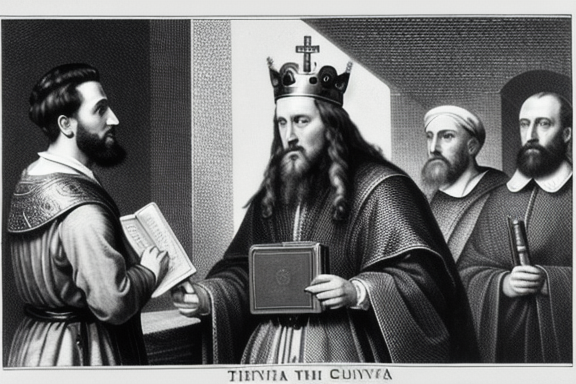Welcome to our exploration of the relationship between King James and the Geneva Bible. In order to understand the significance of their relationship, we must first delve into the backgrounds of both King James and the Geneva Bible. These historical figures and texts played pivotal roles in shaping the religious landscape of their time, and their influence can still be felt today.
The Geneva Bible, on the other hand, was a popular English translation of the Bible during the Protestant Reformation. It was first published in Geneva, Switzerland, in 1560. This translation was unique in that it included extensive study notes and commentary, providing readers with a comprehensive understanding of the text. The Geneva Bible quickly gained popularity among English-speaking Protestants and became the Bible of choice for many individuals and families.
Understanding the relationship between King James and the Geneva Bible is important because it sheds light on the factors that led to the creation of the King James Version (KJV) of the Bible. During King James’ reign, there was a growing dissatisfaction with the Geneva Bible among some religious leaders and scholars. They believed that the study notes and commentary in the Geneva Bible contained biased interpretations and theological views that did not align with their own beliefs. This dissatisfaction led to a desire for a new translation that would be more neutral and authoritative.
In 1604, King James convened a group of scholars to undertake a new translation of the Bible, which eventually resulted in the publication of the King James Version in 1611. The translators of the KJV aimed to create a translation that would be accessible to all English-speaking people, free from the perceived biases of the Geneva Bible. They also sought to maintain the poetic beauty and linguistic richness of the earlier translations, while ensuring accuracy and fidelity to the original Hebrew and Greek texts.
The relationship between King James and the Geneva Bible is a fascinating and complex one. It involves considerations of religious beliefs, political motivations, and scholarly pursuits. By delving into this relationship, we can gain a deeper understanding of the historical context surrounding the creation of the King James Version and appreciate the impact it has had on English-speaking Christianity over the centuries.
Historical Context
The Geneva Bible, first published in 1560, quickly became one of the most popular English translations of the Bible during the Protestant Reformation. Its accessibility and use of study aids, such as chapter summaries, cross-references, and explanatory notes, made it a beloved and trusted resource for English-speaking Christians. The Geneva Bible’s emphasis on individual interpretation and its influence on the Puritan movement solidified its place in history as an influential translation.
However, the Geneva Bible did not receive universal acclaim, especially from King James I of England. King James, who ascended to the throne in 1603, had his own reasons for disliking the Geneva Bible and sought to establish a new translation that would align more closely with his own beliefs and ideals.
There were several reasons for King James’ dislike of the Geneva Bible:
- Political motivations: King James was keen on consolidating his power and establishing his authority as the head of both the church and the state. The Geneva Bible contained marginal notes that criticized the monarchy and advocated for limited government, which threatened the king’s authority. King James saw the Geneva Bible as a potential threat to his rule and sought to create a translation that would be more supportive of his role as king.
- Religious motivations: King James was a proponent of the divine right of kings, a belief that monarchs derive their authority directly from God. The Geneva Bible’s notes, which favored a democratic form of church government, clashed with King James’ belief in the hierarchical structure of the Church of England. He wanted a translation that would reinforce the idea of the king’s divine authority and promote a more hierarchical view of the church.
King James’ dislike of the Geneva Bible ultimately led to the commissioning of a new translation, known as the King James Version (KJV) or the Authorized Version. The KJV, completed in 1611, was intended to be the new standard translation for the English-speaking world and was carefully crafted to align with King James’ political and religious beliefs.
It is important to understand the historical context surrounding King James’ dislike of the Geneva Bible in order to appreciate the significance of the King James Version and its impact on English literature, language, and religious traditions.
Differences between the Geneva Bible and the King James Bible
When comparing the Geneva Bible and the King James Bible, several key differences emerge, spanning translation methods and philosophies, language and stylistic variations, as well as theological and doctrinal discrepancies. These variations played a significant role in shaping the two versions and contributed to the eventual preference for the King James Bible in the English-speaking world.
One of the primary differences lies in their translation methods and philosophies. The Geneva Bible, first published in 1560, was translated by English exiles in Geneva during the reign of Queen Mary I. These scholars aimed to produce a Bible that was both accurate and accessible to the common people. As a result, the Geneva Bible emphasized clarity and readability, using a more straightforward and vernacular language compared to earlier English translations.
In contrast, the King James Bible, published in 1611, was a collaborative effort of scholars appointed by King James I of England. They followed a different translation philosophy known as formal equivalence, striving for a word-for-word translation from the original Hebrew and Greek texts. This approach focused on preserving the structure and style of the original languages, sometimes resulting in more complex and archaic language.
Another notable distinction between the two versions is the language and stylistic variations. The Geneva Bible was heavily influenced by the Protestant Reformation and the rise of Puritanism. Its translators often introduced interpretive elements into the text, adding marginal notes, cross-references, and explanatory comments. These features aimed to provide readers with a comprehensive understanding of the biblical text and its application to daily life.
In contrast, the King James Bible adopted a more conservative approach. Its translators aimed to maintain a neutral and objective tone, avoiding interpretive elements. However, they did incorporate some stylistic variations to enhance the literary quality of the text. For example, the use of formal and poetic language, such as the famous “thee” and “thou” pronouns, added a sense of reverence and grandeur to the King James Bible.
Theological and Doctrinal Discrepancies
Beyond translation methods and language variations, the Geneva Bible and the King James Bible also differed in their theological and doctrinal perspectives. The Geneva Bible, influenced by Reformed theology, emphasized the sovereignty of God and the responsibility of individuals to live according to His commands. It included extensive study aids and commentary that reflected the theological perspectives of its translators.
The King James Bible, on the other hand, aimed for a more ecumenical approach, seeking to bridge theological divides within the Church of England. The translators carefully navigated controversial theological topics and sought a more inclusive language to appeal to a broader audience. Despite their efforts, some theological discrepancies between the two versions remain, reflecting the theological diversity of the time.
Impact on Religious Landscape
The reign of King James I had a profound influence on the English-speaking Protestant world, particularly in the realm of biblical translation and religious practice. One of the most significant outcomes of his reign was the transition from the Geneva Bible to the King James Bible, which had a lasting impact on Christianity and the English language itself.
Transition from the Geneva Bible to the King James Bible
The Geneva Bible, first published in 1560, was the preferred Bible of the English Protestant reformers. It was known for its comprehensive study notes and its emphasis on individual interpretation of Scripture. However, King James I took issue with some of the marginal notes in the Geneva Bible, which he believed challenged his authority.
In 1604, King James convened the Hampton Court Conference, where he expressed his desire for a new translation that would be more in line with the established Church of England. This led to the commissioning of a new English Bible translation, which would later become known as the King James Bible or the Authorized Version.
The translation of the King James Bible began in 1604 and was completed in 1611. It was a collaborative effort involving a team of scholars who aimed to create a more accurate and readable English translation. The King James Bible retained some elements from the Geneva Bible, such as its chapter and verse divisions, but it also introduced stylistic and linguistic changes that would shape the English language for centuries to come.
Legacy and Lasting Significance of the King James Bible
The King James Bible had a profound impact on religious and literary history. It became the standard English Bible for the Church of England and played a crucial role in defining Protestant theology and worship. Its influence extended beyond the church walls, permeating various aspects of English society and culture.
Language and Stylistic Influence: The King James Bible is renowned for its distinctive language and poetic style. Its translators aimed to create a text that was both faithful to the original Hebrew and Greek manuscripts and aesthetically pleasing to the ear. The result was a translation that showcased the beauty and power of the English language, leaving a lasting impact on literature, poetry, and rhetoric.
Religious and Theological Significance: The King James Bible became the cornerstone of Protestant Christianity, shaping religious beliefs and practices. Its widespread use helped to unify English-speaking Protestants under a common biblical text, fostering a sense of religious identity and community.
Cultural and Historical Influence: The King James Bible played a pivotal role in the development of the English language and its spread across the globe. Its phrases and expressions became deeply ingrained in English literature, music, and popular culture. The King James Bible also had a significant impact on the religious and political landscape of colonial America, influencing the values and ideals of the early settlers.
In conclusion, the transition from the Geneva Bible to the King James Bible under King James I’s reign had a profound and enduring impact on the religious landscape. The King James Bible’s language, religious significance, and cultural influence have made it one of the most important and enduring works in the English language.

Rockin’ the faith, one verse at a time!
Growing up, the Bible’s stories deeply impacted me. Now, with over 15 years of preaching experience, I blend timeless teachings with modern technology, making them relevant for today’s world.
Bible Hub Verse is my platform to share historical insights and thought-provoking articles, exploring both familiar and uncommon Christian topics. My passion is building a welcoming online space for everyone to learn, grow in their faith, and discover the Bible’s enduring message.
Join the journey!
God bless you.





